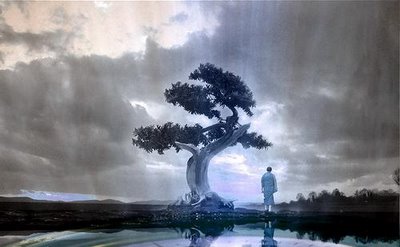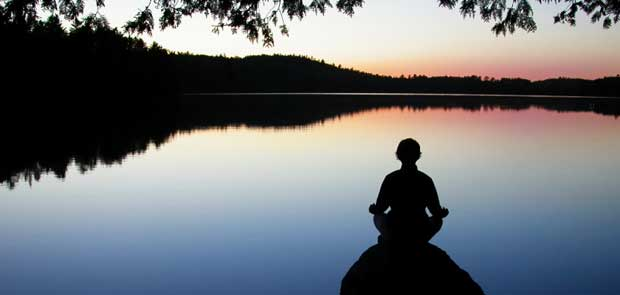
Twenty-some years ago, flat on my back doing “trance work,” I felt a tingling in the forehead between the eyes. I pictured the tingling as a small feather moving in a dime-sized circle, pleasant and subtle. After a while I got up and noticed that the sensation persisted.
Soon I was flat on my back again, engaging trance work with the intention of getting out of my body. While I did pop out for short moments, the feather-touch-between-the-eyes is what wanted to happen. The dime-circle spread out to baseball size, and then my head was encircled by a gently-vibrating “halo,” which I pictured as golden and bright. I got up from trance work and noticed that the halo persisted.
Over the days, weeks, months and years to come, this small sensation in my forehead enlarged and matured to encompass my entire body. New centers of energetic vibration got “turned on” in the process, corresponding to the chakras with special attention to the lower two. In meditation the routine included a rocket blast of energy down there, firing up through the spine to join the pleasant sensations in and around the head. I would get up from trance work or meditation to find that, while the intensity and focus of these experiences decreased, the energy itself never subsided, never turned off.
I became and have remained saturated in jhana/samadhi, on and off the cushion, all day, all night, no matter what the circumstances of my waking life.
Speaking with others who have found jhana/samadhi in whatever way it came to them, I’ve discovered that my experience is not unique. There is something about the process of dipping into deeper states of contemplation, coming out then going back in, over and over and over, that gradually integrates the absorptive experience such that it never fully dissipates. I don’t know how this plays out in others, but for me there have been two diverging outcomes:
1) peace and tranquility gained through long meditation sessions have gradually permeated my moment-to-moment existence, always calling me, always inviting me, always guiding me to surrender to peace and tranquility.
2) anxiety, trepidation, fear, anger, resentment and all manner of over-sensitive emotional suffering have risen from the depths, releasing in ways that I would never have chosen for myself or anyone else.
These polar extremes are ever-present: I am either contentedly basking in peace, joy, ecstasy, tranquility and equanimity, or I am wracked with emotional turmoil, projecting onto others while condemning myself for failing to act like an enlightened being.
What I’ve come to realize is that there is a profound trade-off when one experiences the self-arising bliss, joy and ecstasy of jhana/samadhi, which completely saturates the contemplative over time. The trade-off states that we are allowed to experience wondrous and succor-providing “Divine” energy on an ever-present basis – but this energy will inevitably put us face-to-face with every conceivable shadow from the depths of our being, and we will be required to confront ourselves at a level of honesty that is brutal and transformative. The nature of this transformation is, for as long as necessary, destructive – i.e., it breaks us down at the ego level, and it never, ever lets up.
So it is a bitter-sweet proposition. On the one hand, there is never a moment when I’m not blessed with self-arising bliss, joy and ecstasy, with instant access to peace, tranquility and well-being. On the other hand, the relentless effect of this Divine energy is to chip away at my self-conception, challenging all beliefs about myself and the world I live in. It brings up heavy-duty dark emotions and spews them forth at a moment’s notice. It brings shame and embarrassment, it throttles self-confidence, it exposes me as a raw, gaping wound for any and all to see – or at least this is how it often feels. Once it begins, there is no turning back – and there is never a guarantee that a particular outcome is in the offing. There is just this experience of being blissed-out all the time, even as the fabric of my world comes under constant questioning without answers – just more questions, more anxiety, more desperate yearning to land on something solid.
What it teaches, finally, is that surrender is not just a noble intention. Surrender is absolutely required, and surrender must be total. This IS a gift and I am gratified that it has happened… but I am also fully aware that jhana/samadhi WILL have its way with me. I can either let go of my own agenda and allow it full access to my driving mechanism, or I can kick, scream and otherwise resist with every ounce of my ego-based strength, somehow thinking that I can produce for myself a pleasant outcome that won’t force me to deal with the darker aspects of my being.
Technically, I am in the thralls of the Dark Night of the Soul, symbolized as a Great Divide between the 2nd and 3rd “material” jhanas. Back in 2009 I wrote:
When engaging the four material jhanas, many hurdles must be negotiated. Emotional hurdles, psychological hurdles, physical hurdles, spiritual hurdles. Hurdles having to do with entrenched beliefs. Hurdles having to do with cultural conditioning. Hurdles having to do with relationships
The biggest hurdle for most contemplatives occurs at the boundary between second and third jhana.
Symbolically, this boundary depicts a “lull” after some initial spiritual epiphany, a “coming down from the mountain” that leads to deflation and disappointment, not to mention a pining for getting back to the sublime states hinted at during the spiritual high.
There’s a lot of that going on, for sure… but I can report from the depths of the Dark Night that there is no “getting back to the sublime states hinted at during the spiritual high.” There is only one defeat after another, requiring one surrender after another, over and over as I learn how to relinquish my ego’s hold on how I think things should be. I know beyond a shadow of a doubt that this is the slow, gruelling death of a self-identity that must be completely blotted out in order for new life to begin. This is what I bargained for, this is what I get.
From both personal experience and encouragement from past and present mystics, I gather that there’s no point in rushing things, and the only sensible choice is to let go, surrender, release, relinquish… and know that I was never in charge to begin with.



